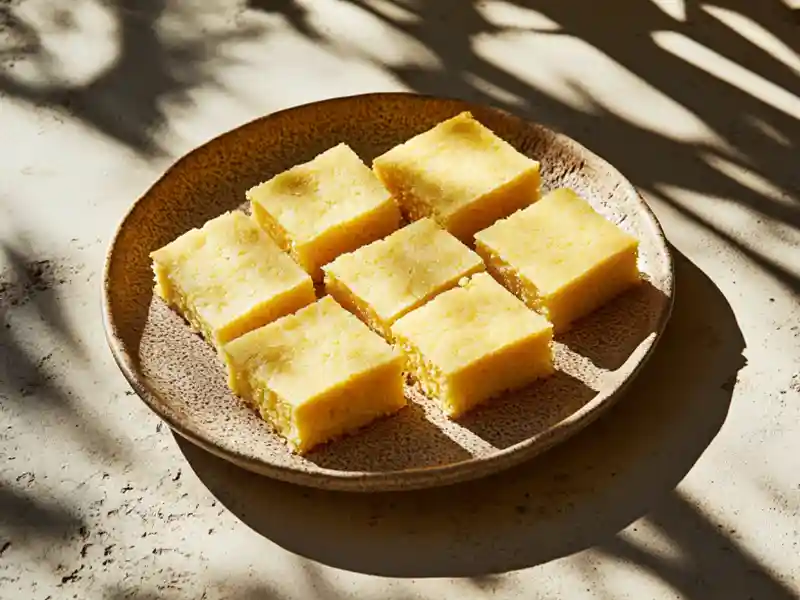This recipe is perfect for those times when you want a simple, no-fuss cornbread. With just three ingredients and a cast iron skillet, you can have delicious cornbread in no time.
Ingredients:
- 1 cup white self-rising cornmeal
- 1 egg
- 1 cup buttermilk (or enough to make a thin batter)
Instructions:
- Preheat oven to 450°F (232°C).
- Oil a cast iron skillet and place it in the oven to heat up.
- In a bowl, combine cornmeal, egg, and buttermilk. Mix until a thin batter forms.
- Carefully remove the hot skillet from the oven.
- Pour batter into the hot skillet.
- Bake for 20 minutes, or until golden brown.
Note: If you don’t have self-rising cornmeal, you can make your own by combining 1 cup of cornmeal, 1 1/2 teaspoons of baking powder, and 1/2 teaspoon of salt.
Nutritional Benefits
- Cornmeal is a great source of carbohydrates, providing energy for a busy day.
- It contains essential nutrients such as iron, magnesium, and B vitamins, contributing to overall well-being.
- Milk provides calcium and vitamin D, vital for healthy bones and immune function.
- Baking powder helps in leavening, turning the cornbread fluffy and light.
Exploring possible additions or upgrades can elevate your cornbread experience even further. Perhaps you’d like to mix in some shredded cheese, sweet corn kernels, or diced jalapeños for a spicy kick. Adding herbs like thyme or rosemary can infuse an earthy aroma, making your cornbread even more enticing and unique!
Cornbread: A Southern Staple with Endless Possibilities
Cornbread, a culinary cornerstone of Southern US cuisine, is a simple quick bread with a rich history and diverse variations. Its humble beginnings trace back to Native American cooking techniques, using ground corn as a staple ingredient. European settlers adapted these methods, and cornbread eventually became a widespread and beloved dish, particularly in the South where corn was readily available.
While the basic ingredients are straightforward – cornmeal, flour, eggs, and buttermilk – the beauty of cornbread lies in its adaptability. From sweet to savory, crumbly to cakey, there’s a cornbread style to suit every palate and occasion.
Tips for Perfect Cornbread
- Use the Right Cornmeal: The type of cornmeal significantly impacts the texture. Fine cornmeal yields a smoother, more cake-like result, while coarser grinds create a coarser, more crumbly texture. Stone-ground cornmeal, with its slightly gritty texture, is often favored for its rustic charm and flavor.
- Don’t Overmix: Overmixing develops gluten, which can make your cornbread tough. Mix the batter just until the ingredients are combined.
- Preheat the Pan: A hot pan, especially a cast iron skillet, ensures a crispy crust. Preheat it in the oven while you prepare the batter.
- Fat is Your Friend: Whether it’s butter, shortening, or bacon grease, fat adds flavor and richness to cornbread. Don’t be afraid to use a generous amount.
- Adjust Liquid as Needed: The amount of liquid needed can vary depending on the cornmeal and humidity. Add buttermilk gradually until you achieve a batter that is pourable but not too thin.
- Baking Time and Temperature: Keep a close eye on your cornbread as it bakes. It’s done when golden brown and a toothpick inserted in the center comes out clean.
Serving Suggestions
Cornbread is incredibly versatile. Here are some ideas:
- Classic Side: Serve it warm with butter, honey, or jam alongside chili, soup, or barbecue.
- Stuffing: Crumble leftover cornbread and use it as a base for savory stuffing recipes, especially for Thanksgiving turkey.
- Cornbread Salad: Crumble cornbread and toss it with fresh vegetables, herbs, and a vinaigrette for a refreshing summer salad.
- Dessert: Sweet cornbread variations, with added sugar or honey, pair beautifully with fruit, ice cream, or whipped cream.
FAQs about Cornbread
Q: What’s the difference between Northern and Southern cornbread?
A: Northern cornbread typically includes wheat flour and sugar, resulting in a sweeter, cake-like texture. Southern cornbread traditionally omits sugar and relies primarily on cornmeal, producing a more savory, crumbly bread.
Q: Can I use regular milk instead of buttermilk?
A: While buttermilk adds a tangy flavor and helps create a tender crumb, you can substitute with regular milk or a non-dairy alternative. For every cup of buttermilk, use 1 cup of milk mixed with 1 tablespoon of lemon juice or vinegar.
Q: How do I store leftover cornbread?
A: Store cornbread at room temperature, wrapped tightly in plastic wrap or in an airtight container, for up to 3 days. You can also freeze it for longer storage.
Q: Why is my cornbread dry?
A: Several factors can contribute to dry cornbread, including using too much cornmeal, overmixing the batter, or overbaking. Make sure to measure ingredients accurately, mix gently, and keep a close eye on the baking time.
Cornbread is more than just a side dish; it’s a symbol of Southern hospitality and culinary heritage. Whether you enjoy it sweet or savory, crumbly or cakey, cornbread offers a delicious and satisfying taste of tradition.



